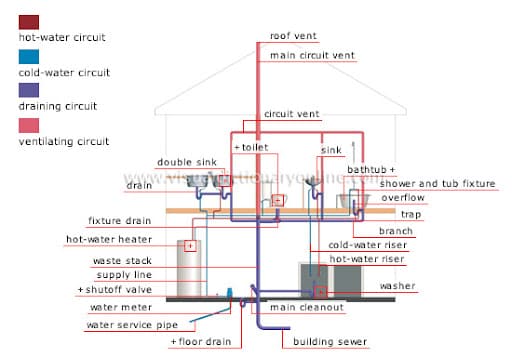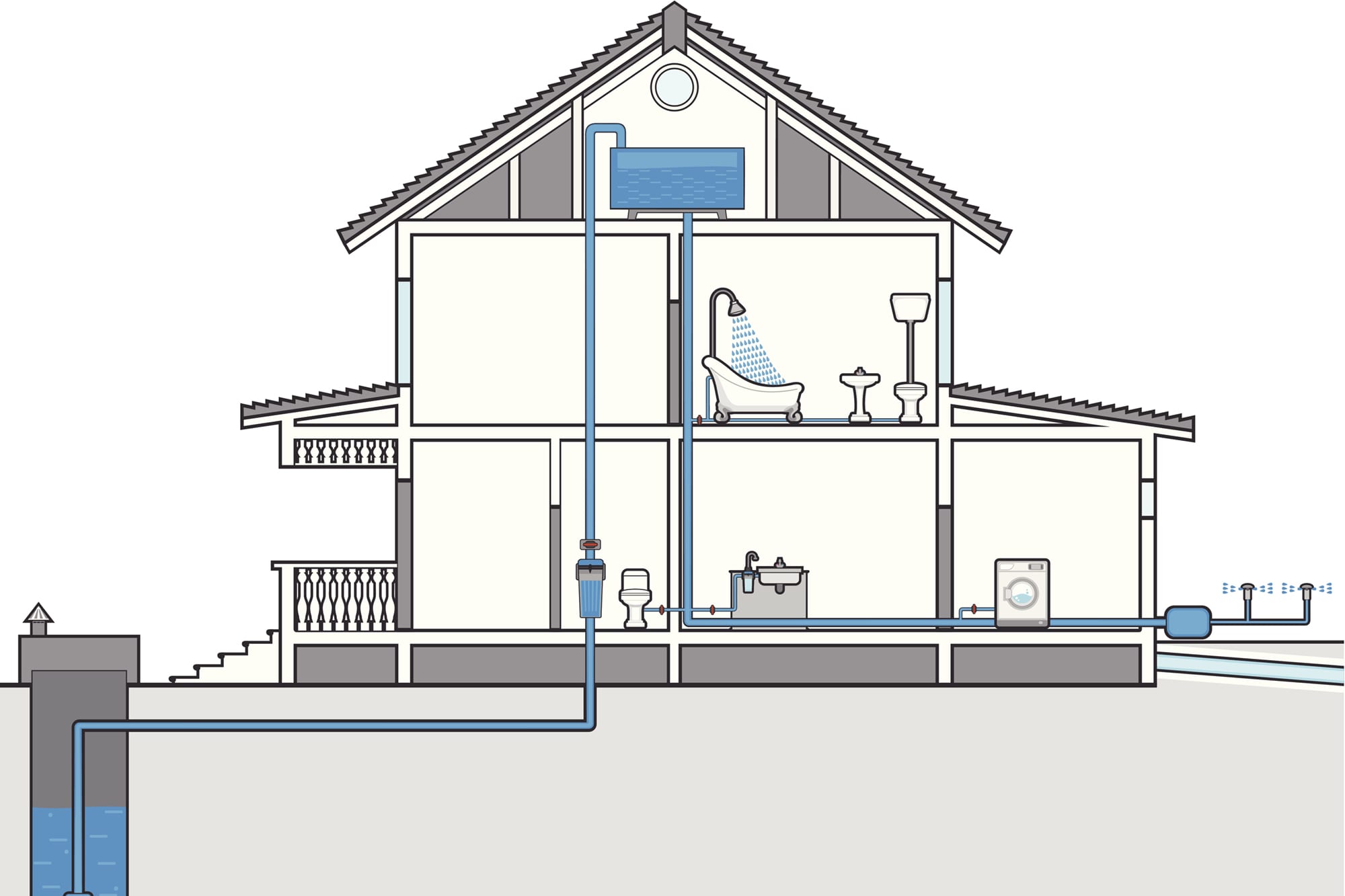The Essential Elements of Your House's Plumbing System
The Essential Elements of Your House's Plumbing System
Blog Article
Just about every person seems to have their unique idea involving Anatomy of a House: Understanding the Components.

Comprehending how your home's plumbing system works is important for each house owner. From supplying tidy water for drinking, cooking, and bathing to safely removing wastewater, a well-kept plumbing system is vital for your family members's wellness and convenience. In this thorough overview, we'll explore the intricate network that makes up your home's plumbing and offer tips on upkeep, upgrades, and managing common concerns.
Introduction
Your home's plumbing system is greater than simply a network of pipelines; it's a complex system that ensures you have accessibility to tidy water and effective wastewater removal. Recognizing its parts and exactly how they work together can aid you stop costly repairs and make certain everything runs efficiently.
Fundamental Components of a Pipes System
Pipes and Tubing
At the heart of your pipes system are the pipes and tubing that lug water throughout your home. These can be made from various products such as copper, PVC, or PEX, each with its benefits in terms of longevity and cost-effectiveness.
Fixtures: Sinks, Toilets, Showers, and so on.
Components like sinks, commodes, showers, and tubs are where water is used in your house. Comprehending how these components connect to the pipes system assists in detecting issues and planning upgrades.
Shutoffs and Shut-off Points
Shutoffs manage the circulation of water in your plumbing system. Shut-off valves are essential throughout emergencies or when you require to make repair services, allowing you to separate parts of the system without disrupting water flow to the whole home.
Water System
Main Water Line
The major water line links your home to the metropolitan water system or an exclusive well. It's where water enters your home and is distributed to numerous fixtures.
Water Meter and Stress Regulator
The water meter actions your water usage, while a stress regulator makes certain that water streams at a risk-free stress throughout your home's plumbing system, stopping damage to pipes and components.
Cold Water vs. Hot Water Lines
Comprehending the difference between cold water lines, which provide water straight from the major, and hot water lines, which carry heated water from the hot water heater, helps in fixing and preparing for upgrades.
Drainage System
Drain Pipes Piping and Traps
Drain pipes bring wastewater far from sinks, showers, and toilets to the drain or septic system. Traps avoid sewage system gases from entering your home and also trap particles that can cause clogs.
Ventilation Pipes
Ventilation pipelines permit air right into the drainage system, stopping suction that could slow down water drainage and cause catches to empty. Appropriate air flow is important for keeping the integrity of your pipes system.
Importance of Appropriate Water Drainage
Ensuring appropriate water drainage avoids back-ups and water damage. Frequently cleansing drains and preserving catches can prevent costly repair work and prolong the life of your pipes system.
Water Heater
Kinds Of Hot Water Heater
Hot water heater can be tankless or typical tank-style. Tankless heating systems warmth water as needed, while containers save warmed water for prompt usage.
Updating Your Pipes System
Factors for Updating
Updating to water-efficient components or changing old pipelines can boost water top quality, reduce water bills, and increase the value of your home.
Modern Plumbing Technologies and Their Benefits
Explore technologies like clever leakage detectors, water-saving commodes, and energy-efficient hot water heater that can conserve cash and minimize environmental effect.
Expense Considerations and ROI
Calculate the upfront costs versus long-term savings when taking into consideration pipes upgrades. Several upgrades spend for themselves with decreased utility bills and fewer repair work.
Exactly How Water Heaters Link to the Plumbing System
Comprehending exactly how hot water heater attach to both the cold water supply and warm water circulation lines aids in detecting concerns like not enough warm water or leakages.
Upkeep Tips for Water Heaters
Consistently purging your hot water heater to get rid of debris, examining the temperature level settings, and inspecting for leaks can extend its lifespan and boost power performance.
Usual Plumbing Issues
Leakages and Their Reasons
Leaks can occur as a result of aging pipes, loosened fittings, or high water stress. Dealing with leakages immediately avoids water damages and mold and mildew growth.
Obstructions and Obstructions
Obstructions in drains pipes and toilets are usually caused by purging non-flushable items or a build-up of oil and hair. Using drainpipe screens and bearing in mind what decreases your drains can protect against blockages.
Indicators of Plumbing Problems to Look For
Low water stress, sluggish drains pipes, foul odors, or uncommonly high water bills are indications of potential pipes problems that must be dealt with without delay.
Plumbing Upkeep Tips
Regular Examinations and Checks
Arrange yearly plumbing examinations to catch issues early. Search for signs of leakages, rust, or mineral buildup in taps and showerheads.
DIY Upkeep Tasks
Easy jobs like cleaning tap aerators, checking for bathroom leakages utilizing color tablets, or protecting revealed pipes in cool climates can avoid significant plumbing problems.
When to Call a Specialist Plumbing
Know when a pipes concern requires expert expertise. Attempting intricate repairs without appropriate expertise can lead to more damage and higher fixing costs.
Tips for Decreasing Water Use
Straightforward habits like taking care of leakages promptly, taking shorter showers, and running complete lots of laundry and dishes can save water and reduced your energy bills.
Eco-Friendly Plumbing Options
Think about lasting pipes products like bamboo for floor covering, which is durable and green, or recycled glass for counter tops.
Emergency situation Readiness
Steps to Take During a Plumbing Emergency situation
Know where your shut-off shutoffs lie and how to turn off the supply of water in case of a ruptured pipeline or significant leakage.
Importance of Having Emergency Get In Touches With Helpful
Maintain call details for regional plumbing technicians or emergency situation solutions conveniently available for quick response during a plumbing crisis.
Environmental Effect and Preservation
Water-Saving Components and Appliances
Installing low-flow faucets, showerheads, and toilets can significantly decrease water usage without sacrificing performance.
DIY Emergency Fixes (When Appropriate).
Short-term fixes like using duct tape to patch a leaking pipeline or positioning a pail under a trickling tap can lessen damages up until an expert plumbing arrives.
Conclusion.
Recognizing the makeup of your home's pipes system equips you to preserve it efficiently, saving time and money on repairs. By adhering to normal upkeep routines and staying informed concerning modern-day plumbing innovations, you can ensure your pipes system runs effectively for years to come.
HOW YOUR PLUMBING SYSTEM WORKS
Which Pipes Do What?
Blue lines = fresh water supply entering the building Red lines = hot water supply entering the building Grey lines = pipes carrying waste away from the building and venting pipes carrying gases away from the building (through the roof) YOUR MAIN PLUMBING SYSTEMS
There are two main plumbing systems that support your home s basic plumbing needs one that brings clean water into your home, and one that sends dirty water away from your home. Connected to the toilet, bath, shower, and other faucets in your home, these two systems keep your water flowing in the right directions.
ACCESSING FRESH WATER
Fresh and clean water is brought into your home through the main water supply line . Filtered through one pipe, this water is pressured to flow into the various fixtures in your home at any given time.
This water can be sourced from a well located on your property, a pond or river (mostly cottages), or, as in most cases, from the city s municipal water treatment centre. However, it is important to note that water that is untreated, such as the water siphoned from ponds or rivers, may not be safe to drink. Personal water supplies always need to be treated for hardness and contaminants before consumed.
MUNICIPAL WATER SUPPLIES
Improve taste and odour Remove sediment Eliminate hardness Reduce chlorine COLD WATER SUPPLY VS. HOT WATER SUPPLY
Cold water flows into your home or building through the service line, which then distributes hot or cold water to your fixtures. This line is most commonly run through a central column that runs floor to floor. Hot water runs in short and straight pipes as the longer the pipeline, the more heat that will be lost in the transfer. Having shorter pipes also allows residents to access hot water more quickly.
WASTE WATER SYSTEM
Your wastewater system is divided into two parts pipes that send wastewater away from your home and venting pipes that send sewer gas away from your home. Sewage water travels through pipes that flush the water and waste towards local sewers that are operated and managed by your city or town. Most sewer systems rely on gravity to move the wastewater to where it needs to go.
The further away from your toilet or sink, the larger wastewater pipes become. This allows for waste to be disposed of from various parts of your home or business at once without pipe blockages. The angle and flow of these pipes are also essential for keeping your waste pipes clear of build up.
https://harrisplumbing.ca/how-your-home-plumbing-system-works/

I recently found that post about Understanding Your Home's Plumbing Anatomy while browsing the internet. Enjoyed our piece? Please quickly share it. Let others discover it. Thanks for going through it.
Learn More Report this page